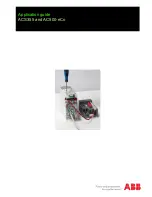
Programming Using Hand-held Terminal
3.5
20 mA TRIM:
this is used to adjust the output current value corresponding to 100%
of the measurement.
The Current Trim shall be carried out as per the following procedure:
Connect the transmitter to the precision ammeter
Select one of the Trim types
Wait a moment for the current to stabilize and inform the transmitter the current
readout of the precision ammeter.
NOTE:
The transmitter presents a resolution that makes it possible to control currents as
low as microamperes. Therefore, when informing the current readout to the
transmitter, it is recommended that data input consider values up to tenths of
microamperes.
Transmitter Adjustment to the Working Range
This function directly affects the transmitter's 4-20 mA output. It is used to define the
transmitter's working range; in this document it is referred to as the transmitter's
calibration. The
LD301
transmitter includes two calibration features:
CALIBRATION WITH REFERENCE:
this is used
to adjust the transmitter's working
range, using a pressure standard as a reference.
CALIBRATION WITHOUT REFERENCE:
this is used
to adjust the transmitter's
working range, simply by having limit values informed by the user.
Both calibration methods define the Working Range Upper and Lower values, in
reference to some applied pressure or simply informed by entered values.
CALIBRATION WITH REFERENCE differs from the Pressure Trim, since
CALIBRATION WITH REFERENCE establishes a relationship between the applied
pressure and the 4 to 20 mA signal, and the Pressure Trim is used to correct the
measurement.
In the transmitter mode, the Lower Value always corresponds to 4 mA and the Upper
Value to 20 mA. In the controller mode, the Lower Value corresponds to PV=0% and
the Upper Value to PV=100%.
The calibration process calculates the LOWER and the UPPER values in a completely
independent way. The adjustment of value does not affect the other. The following rules
shall, however, be observed:
The Lower and Upper values shall be within the range limited by the Minimum and
maximum Ranges supported by the transmitter. As a tolerance, values exceeding
such limits by up to 24% are accepted, although with some accuracy degradation.
The Working Range Span, determined by the difference between the Upper and
Lower Values, shall be greater than the minimum span, defined by [Transmitter
Range / 120]. Values up to 0.75 of the minimum span are acceptable with slight
accuracy degradation.
NOTE:
Should the transmitter operate with a very small span, it will be extremely sensitive
to pressure variations. Keep in mind that the gain will be very high and that any
pressure change, no matter how small, will be amplified.
If it is necessary to perform a reverse calibration, that is, to work with an UPPER VALUE
smaller than the LOWER VALUE, proceed as follows:
Place the Lower Limit in a value as far from the present Upper Value and from the
new adjusted Upper value as possible, observing the minimum span allowed.
Adjust the Upper Value at the desired point and, then, adjust the Lower Value.
This type of calibration is intended to prevent the calibration from reaching, at any
moment, values not compatible with the range. For example: lower value equals to
upper value or separated by a value smaller than the minimum span.
Summary of Contents for ld301
Page 14: ...LD301 Operation and Maintenance Instruction Manual 1 8...
Page 18: ...LD301 manual de Instru es Opera o e manuten o 2 4 Fig 2 3 LD301 Software Block Diagram...
Page 50: ...LD301 Operation and Maintenance Instruction Manual 4 16...
Page 55: ...Maintenance Procedure 5 5 Fig 5 1 Exploded View...
Page 62: ...LD301 Operation and Maintenance Instruction Manual 5 12...
Page 70: ...APPENDIX A...
















































